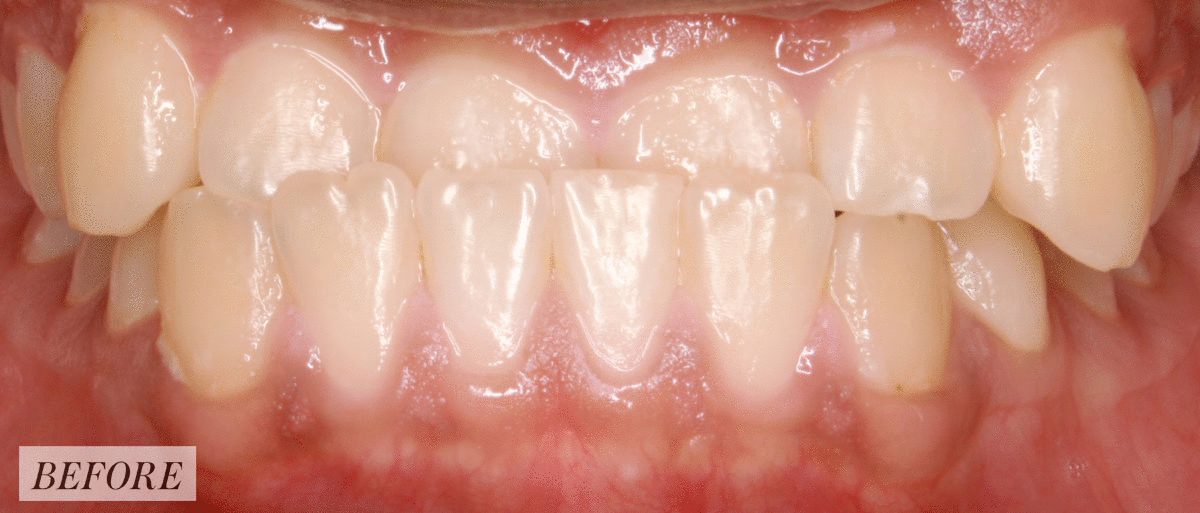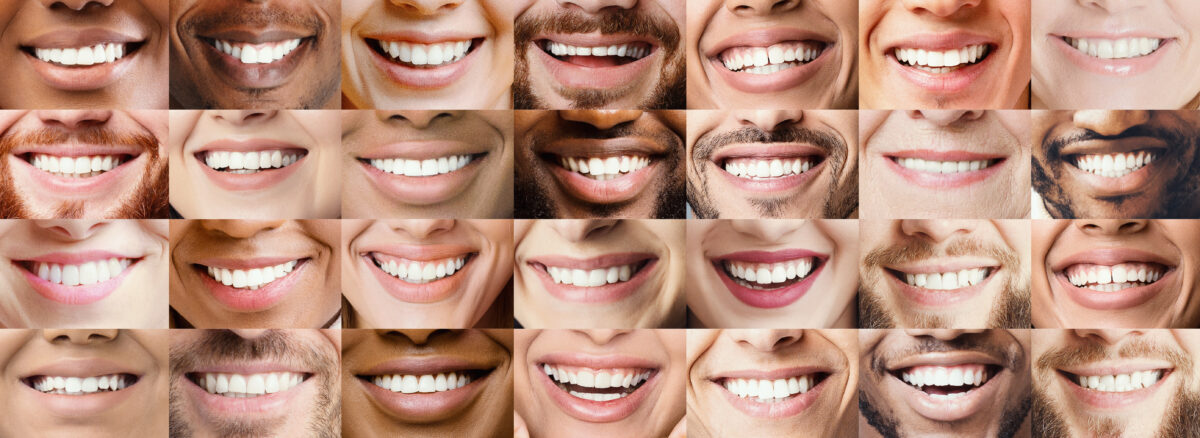Everything You Need to Know About InBrace — and Its Revolutionary Teeth-Straightening Technique
We asked dental experts to debunk a few teeth-straightening myths and explain how InBrace, a personalized Smartwire, might be the best option.
If you’re living with crowded teeth or have gaps in between, a crooked smile that makes you self-conscious, or a jaw that doesn’t align when you close it, you’ve probably considered getting orthodontic treatment, only to talk yourself out of it for one reason or another. You’re in good company. Millions of adults deal with these issues daily.
But teeth-straightening has come a long way from the rubber bands and metal brackets of our youth and even the plastic aligner that has been around for over 20 years. To help you debunk some of the myths that might be holding you back from getting the help you need, Allure spoke to a dentist and an orthodontist about the realities of straightening your teeth in 2021.MYTH #1: Straightening my teeth will make me feel awkward, plus I’ll have to wear braces forever to see a result.
REALITY: Generally, people who need orthodontic treatment are dealing with a malocclusion, which means they have teeth that are crooked or crowded, or a jaw that doesn’t line up well when they bite down. There’s no standard treatment time for malocclusion — no one but your orthodontist can suggest how long it’ll take. Your treatment depends on how much correction your teeth need, in addition to how well you’re able to follow your orthodontist’s directions and whether you use braces, aligner trays, or another option to straighten your teeth.
However, modern teeth-straightening options for adults tend to take less time than traditional archwire and bracket systems. And people who get treatment with clear aligners may see a shorter treatment time.
InBrace, a brand-new, state-of-the-art teeth-straightening system, uses a personalized Smartwire that creates predictable tooth movement. “InBrace is hidden, automated, and hassle-free,” says John Pham, a practicing orthodontist in California and CEO and cofounder of InBrace. “The personalized Smartwire is applied to the back of the teeth and is programmed to move your teeth in a way that’s healthy and fast, all while remaining completely concealed. The Smartwire discreetly uses proprietary Gentleforce™ technology, a light pressure that gently and continuously moves teeth into place with custom AI programming that’s unique to every smile.”



When it comes to timing, “While results vary, InBrace has been shown to produce results in up to half the time, half the number of office visits, and with less pain than traditional braces or aligners,” says Pham. “[With InBrace], the wow really starts right away.”MYTH #2: I’m too old to straighten my teeth.
REALITY: It’s true that the ideal time for orthodontic treatment is your adolescent years, when your jaw is still growing into its adult shape, but it’s actually never too late to take action to get the smile you’ve always wanted.
“Age is never an excluding factor,” says Zachary E. Linhart, a cosmetic dentist based in New York City and Greenwich, Connecticut, who adds that patients from 10 to 90 seek out corrective orthodontia.MYTH #3: There aren’t any real health benefits — and I can’t prioritize a treatment that’s purely cosmetic.
REALITY: Actually, getting your teeth straightened can be a boon to your health.
“There are many health benefits to properly aligned teeth and a healthy bite,” says Linhart. “Crowded teeth can lead to unhealthy gums, bone loss, and eventual tooth loss. In addition, malocclusion can cause premature tooth wear, abfractions [notches in your teeth], and even tooth fracture.” Having teeth that align properly improves the health of your gums and improves the durability of your teeth.
“Most of the cases of orthodontics we perform in the office, in fact, are to improve the function of the teeth and prevent further damage, rather than just for looks alone,” says Linhart.MYTH #4: It’s going to hurt, and it’ll make me talk funny.
REALITY: Many people associate braces with painful symptoms like headaches and pain inside the mouth. They worry about changes they might have to make to their diet and whether they’ll sound different when they speak once they have braces on.
While all these worries are valid, they tend to be overblown. Modern tooth-straightening options are really a different experience entirely. “Usually, the discomfort experienced with orthodontics is from the tightness of the aligners,” Linhart says. “This can usually be overcome with over-the-counter painkillers and typically subsides within a day or two of using a new set of aligners.” He also notes that almost all people who get orthodontic treatment are able to adapt very well to their chosen treatment method.
“Like any teeth-straightening option, [with InBrace] there will be some initial side effects as your mouth gets used to movement happening,” says Pham. “There is an adjustment period of about two weeks during which patients may experience some discomfort and a slight lisp as they adapt to the Smartwire.” But after that, it’s pretty smooth sailing, he says: “InBrace doesn’t affect daily life, and patients are able to drink, eat, and floss as normal. There are no weekly tray changes, which means less visits to your ortho and no painful monthly tightenings.”MYTH #5: I just can’t afford the cost upfront.
REALITY: One of the biggest hang-ups people have about getting teeth-straightening treatments is the cost. And yes, in the past, getting straight teeth as an adult could be a years-long ordeal that required a lot of your time and a lot of your money.
But now, some dental insurance plans cover part of the cost of adult teeth alignment, and flexible spending accounts can typically be used to pay for your treatments tax-free. These options can significantly lower your costs.
What’s more, you often don’t have to pay your out-of-pocket teeth-straightening costs up front. After a consultation, your provider will give you an estimate for your entire treatment, and you can choose to pay in installments or put the balance on an interest-free credit card that’s designed for health services.


If you’re living with crowded teeth or have gaps in between, a crooked smile that makes you self-conscious, or a jaw that doesn’t align when you close it, you’ve probably considered getting orthodontic treatment, only to talk yourself out of it for one reason or another. You’re in good company. Millions of adults deal with these issues daily.
But teeth-straightening has come a long way from the rubber bands and metal brackets of our youth and even the plastic aligner that has been around for over 20 years. To help you debunk some of the myths that might be holding you back from getting the help you need, Allure spoke to a dentist and an orthodontist about the realities of straightening your teeth in 2021.MYTH #1: Straightening my teeth will make me feel awkward, plus I’ll have to wear braces forever to see a result.
REALITY: Generally, people who need orthodontic treatment are dealing with a malocclusion, which means they have teeth that are crooked or crowded, or a jaw that doesn’t line up well when they bite down. There’s no standard treatment time for malocclusion — no one but your orthodontist can suggest how long it’ll take. Your treatment depends on how much correction your teeth need, in addition to how well you’re able to follow your orthodontist’s directions and whether you use braces, aligner trays, or another option to straighten your teeth.
However, modern teeth-straightening options for adults tend to take less time than traditional archwire and bracket systems. And people who get treatment with clear aligners may see a shorter treatment time.
InBrace, a brand-new, state-of-the-art teeth-straightening system, uses a personalized Smartwire that creates predictable tooth movement. “InBrace is hidden, automated, and hassle-free,” says John Pham, a practicing orthodontist in California and CEO and cofounder of InBrace. “The personalized Smartwire is applied to the back of the teeth and is programmed to move your teeth in a way that’s healthy and fast, all while remaining completely concealed. The Smartwire discreetly uses proprietary Gentleforce™ technology, a light pressure that gently and continuously moves teeth into place with custom AI programming that’s unique to every smile.”



When it comes to timing, “While results vary, InBrace has been shown to produce results in up to half the time, half the number of office visits, and with less pain than traditional braces or aligners,” says Pham. “[With InBrace], the wow really starts right away.”MYTH #2: I’m too old to straighten my teeth.
REALITY: It’s true that the ideal time for orthodontic treatment is your adolescent years, when your jaw is still growing into its adult shape, but it’s actually never too late to take action to get the smile you’ve always wanted.
“Age is never an excluding factor,” says Zachary E. Linhart, a cosmetic dentist based in New York City and Greenwich, Connecticut, who adds that patients from 10 to 90 seek out corrective orthodontia.MYTH #3: There aren’t any real health benefits — and I can’t prioritize a treatment that’s purely cosmetic.
REALITY: Actually, getting your teeth straightened can be a boon to your health.
“There are many health benefits to properly aligned teeth and a healthy bite,” says Linhart. “Crowded teeth can lead to unhealthy gums, bone loss, and eventual tooth loss. In addition, malocclusion can cause premature tooth wear, abfractions [notches in your teeth], and even tooth fracture.” Having teeth that align properly improves the health of your gums and improves the durability of your teeth.
“Most of the cases of orthodontics we perform in the office, in fact, are to improve the function of the teeth and prevent further damage, rather than just for looks alone,” says Linhart.MYTH #4: It’s going to hurt, and it’ll make me talk funny.
REALITY: Many people associate braces with painful symptoms like headaches and pain inside the mouth. They worry about changes they might have to make to their diet and whether they’ll sound different when they speak once they have braces on.
While all these worries are valid, they tend to be overblown. Modern tooth-straightening options are really a different experience entirely. “Usually, the discomfort experienced with orthodontics is from the tightness of the aligners,” Linhart says. “This can usually be overcome with over-the-counter painkillers and typically subsides within a day or two of using a new set of aligners.” He also notes that almost all people who get orthodontic treatment are able to adapt very well to their chosen treatment method.
“Like any teeth-straightening option, [with InBrace] there will be some initial side effects as your mouth gets used to movement happening,” says Pham. “There is an adjustment period of about two weeks during which patients may experience some discomfort and a slight lisp as they adapt to the Smartwire.” But after that, it’s pretty smooth sailing, he says: “InBrace doesn’t affect daily life, and patients are able to drink, eat, and floss as normal. There are no weekly tray changes, which means less visits to your ortho and no painful monthly tightenings.”MYTH #5: I just can’t afford the cost upfront.
REALITY: One of the biggest hang-ups people have about getting teeth-straightening treatments is the cost. And yes, in the past, getting straight teeth as an adult could be a years-long ordeal that required a lot of your time and a lot of your money.
But now, some dental insurance plans cover part of the cost of adult teeth alignment, and flexible spending accounts can typically be used to pay for your treatments tax-free. These options can significantly lower your costs.
What’s more, you often don’t have to pay your out-of-pocket teeth-straightening costs up front. After a consultation, your provider will give you an estimate for your entire treatment, and you can choose to pay in installments or put the balance on an interest-free credit card that’s designed for health services.
Click here to schedule your inbrace consultation with Dr. Gray Orthodontic Specialists!
Authored by InBrace

